
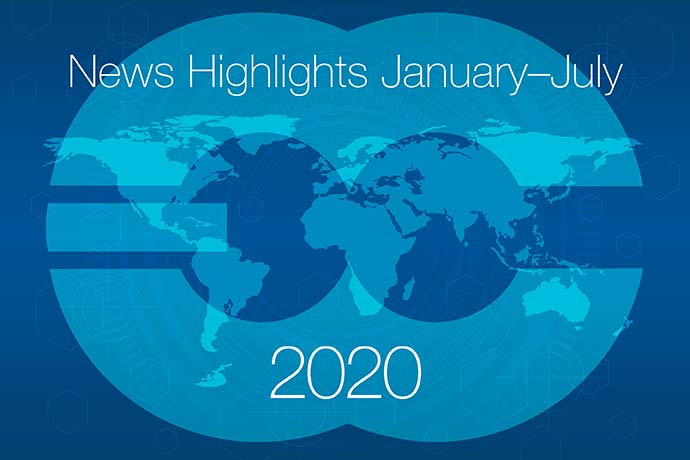
ECMWF news highlights in the first seven months of 2020 include an upgrade of ECMWF’s Integrated Forecasting System that improved forecasts; a new supercomputer contract; projects and workshops to drive forward weather science; and new data and insights on climate change and atmospheric composition from the EU-funded Copernicus services implemented by ECMWF.
Better forecasts
In June, a wide-ranging upgrade of ECMWF’s Integrated Forecasting System (IFS) improved global weather forecasts and substantially improved analyses and forecasts in the stratosphere. The upgrade to IFS Cycle 47r1 brought many changes in data assimilation and Earth system modelling.
For example, a change in the model reduced numerical errors accumulating at high horizontal resolution due to insufficient vertical resolution in the stratosphere. This was achieved by moving from third-order (cubic) to fifth-order (quintic) vertical interpolation.
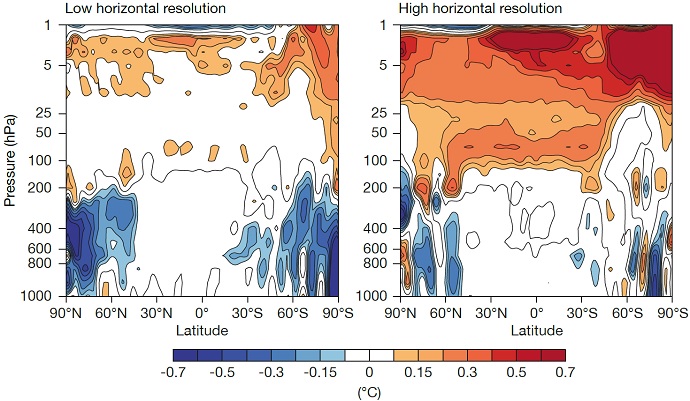
These plots show differences in zonally (latitudinally) averaged temperature between quintic and cubic vertical interpolation forecasts at a grid spacing of about 79 km (left) and about 9 km (right). The plots show that quintic vertical interpolation warms the stratosphere more at high horizontal resolution, thus reducing the cold bias at that resolution. Mean values over 31 forecasts starting in July 2017 and valid at day 10 are shown.
New output data in IFS Cycle 47r1 include a tropical cyclone wind radii product, which will facilitate the identification of wind-related hazards.
The chart shows an HRES wind radii forecast (IFS Cycle 47r1) for the 34-knot wind threshold up to 240 hours ahead, initialised at 12 UTC on 30 August 2019. The red dots indicate the predicted centre of Hurricane Dorian at 12-hour intervals.
On 9 January 2020, ECMWF started assimilating wind data from the European Space Agency's Aeolus satellite operationally after tests showed that they significantly improve weather forecasts.
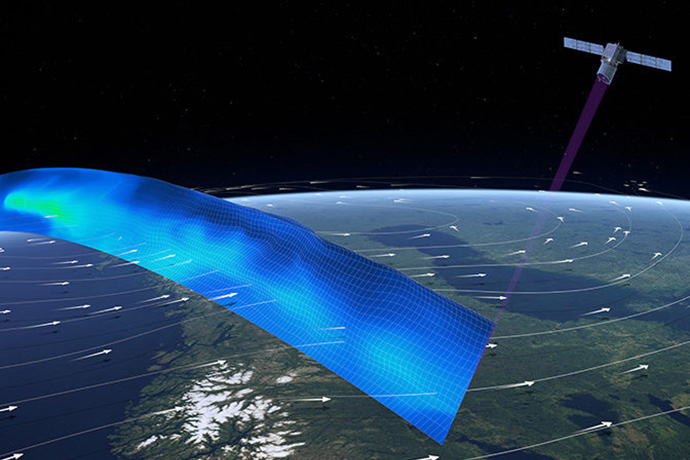
Aeolus is a polar-orbiting satellite which sends laser light into the atmosphere and measures the backscatter to obtain information on winds in the direction perpendicular to the satellite’s path. (Image: ESA/ATG Medialab)
ECMWF users were updated on all these developments and more during this year’s Using ECMWF’s Forecasts event (UEF2020) from 1 to 4 June 2020. The meeting, held virtually because of COVID-19, attracted 227 people from 43 countries.

The theme of UEF2020 was ‘Keeping users at the heart of operations’.
Earth system observations
In March, the World Meteorological Organization (WMO) and ECMWF launched a new web-based interface to help monitor the availability and quality of global meteorological observations.
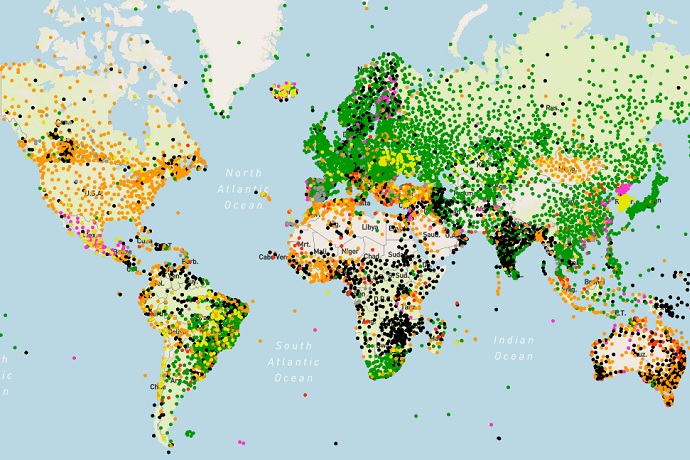
Six-hour WDQMS land-surface observation availability map on 8 March 2020 (green means fully reporting).
A coordinated response involving EUMETNET, national meteorological services and private companies helped to mitigate any adverse effects of the loss of aircraft-based observations on weather forecasts after a sharp drop in flights due the COVID-19 pandemic.

Numbers of global aircraft reports received at ECMWF per day. The regular dips reflect reductions in the numbers at weekends. There is some thinning and a small proportion of rejections so that the number assimilated (green) is less than the number received (blue). Most reports are received as part of the WMO’s Aircraft Meteorological Data Relay (AMDAR) programme.
Driving forward weather science
At the start of 2020, a group of ECMWF scientists embarked upon a project to carry out ground-breaking global weather and climate simulations at 1 km resolution after they were awarded time on the world’s most powerful supercomputer. The award is one of 47 made by the US INCITE programme for 2020 after a highly competitive selection process.
Nils Wedi, Head of Earth System Modelling at ECMWF, has reported first results in a blog post.

The US Incite award project made it possible to simulate deep convection explicitly at the global scale. (Photo: Ivica Brlić, WMO 2018 Calendar, CC BY-NC-ND 2.0)
ECMWF also signed a four-year contract worth over 80 million euros with Atos for the supply of its BullSequana XH2000 supercomputer. ECMWF’s Council of Member States gave the Centre the green light for the deal during its session in December 2019.
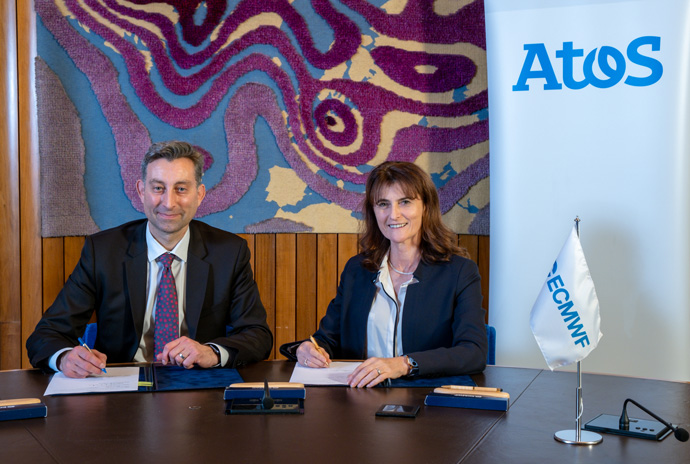
Atos Senior Executive Vice-President Adrian Gregory, CEO UK&I, and ECMWF Director-General Florence Rabier signed the contract. (Photo: Stephen Shepherd)
In February, 80 of the world’s top experts on using satellite cloud and precipitation observations in numerical weather prediction came together at ECMWF to review progress and chart the way ahead. The workshop, organised jointly with EUMETSAT’s NWP Satellite Application Facility (SAF) and the US Joint Center for Satellite Data Assimilation (JCSDA), followed similar events in 2005, 2010 and 2015.
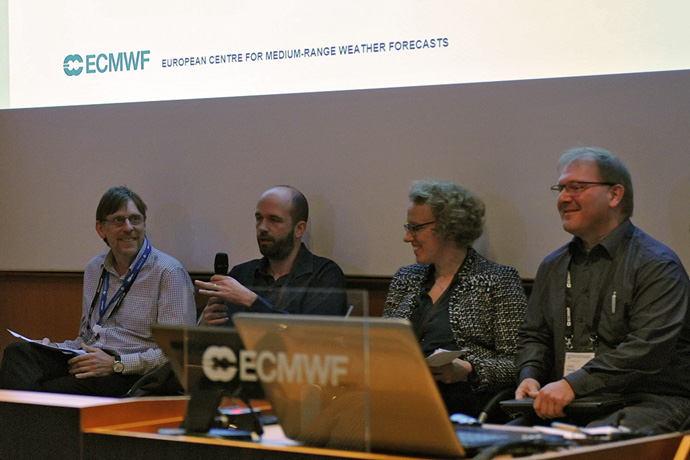
Panel debates at the satellite observations workshop provided opportunities for interaction between different communities of researchers. From left to right: Stephen English (Head of Earth System Assimilation at ECMWF), Jason Otkin (University of Wisconsin-Madison, US), Nadia Fourrié (Centre National de Recherches Météorologiques, France), and Ulrich Blahak (German national meteorological service, DWD).
A few days later, experts discussed the potential for improvements in aircraft weather observation numbers, quality and metadata if numerical weather prediction centres work with the WMO, EUMETNET and the aviation sector.
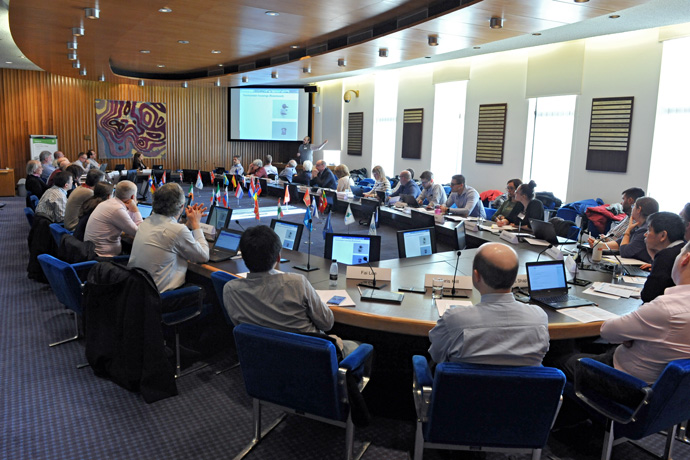
Aircraft observation workshop presentations were given in ECMWF’s Council Chamber.
In March, ECMWF brought together over 100 experts in a virtual workshop to discuss how the latest research on a type of air flow known as warm conveyor belts can help to improve weather forecasts.
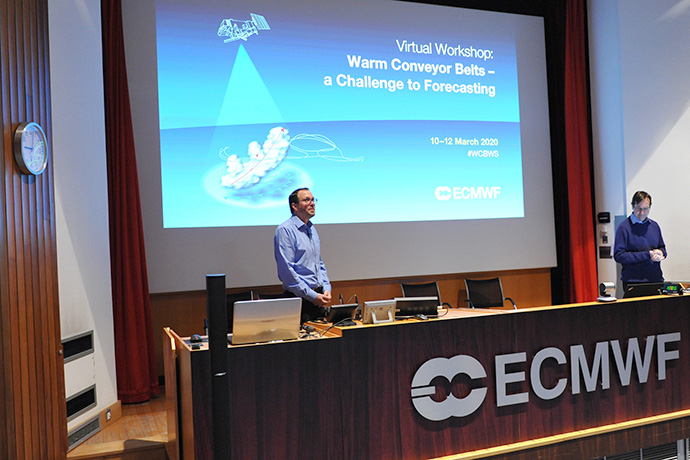
ECMWF Director of Forecasts Florian Pappenberger (left) opened the workshop, which external participants attended remotely because of the COVID-19 pandemic.
A project that ended in April made progress in using visible light satellite data to estimate the concentration of small particles suspended in the atmosphere (aerosols). Five scientists, including four from ECMWF, participated in this two-year ESA-funded project called ARAS (Aerosol Radiance Assimilation Study).
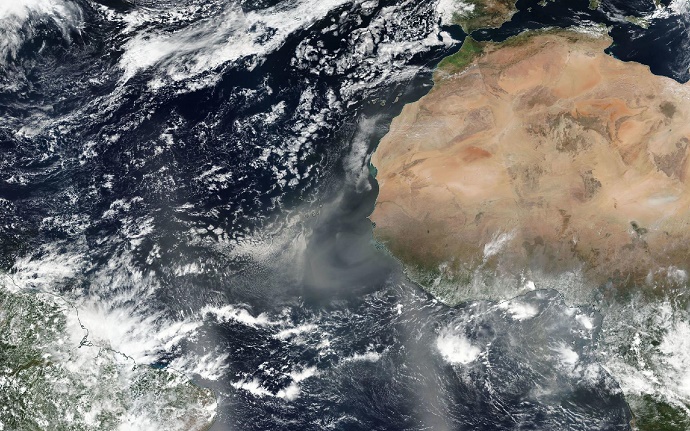
This visible light satellite image shows large plumes of dust off the west coast of Africa and over the Gulf of Guinea on 1 March 2017. (Image: NASA)
In July, the fellowship terms for ECMWF’s first three Fellows came to an end. Professors Tilmann Gneiting, Rupert Klein and Tim Palmer contributed to ECMWF’s work on the calibration and post-processing of forecasts; novel numerical methods; the use of ‘single precision’ in ECMWF’s Integrated Forecasting System (IFS); predictability; and machine learning.

Left to right: Professor Tilmann Gneiting (Heidelberg Institute for Theoretical Studies (HITS) and Karlsruhe Institute of Technology (KIT)), Professor Rupert Klein (Freie Universität Berlin) and Professor Tim Palmer (University of Oxford).
ECMWF’s Copernicus services
In January, ECMWF released global data on weather-induced, outdoor thermal stress and discomfort in human beings covering the period from 1979 to today. The data were made available for download from the Climate Data Store run by ECMWF as part of the EU-funded Copernicus Climate Change Service (C3S).

The map shows Universal Thermal Climate Index values between 24 June and 2 July 2019, according to the reanalysis dataset released by ECMWF.
In April, a detailed report on the state of the European climate, released by the EU-funded Copernicus Climate Change Service (C3S) implemented by ECMWF, confirmed that 2019 was the warmest year on record, continuing a trend that means 11 of the 12 warmest years in Europe have occurred since 2000.
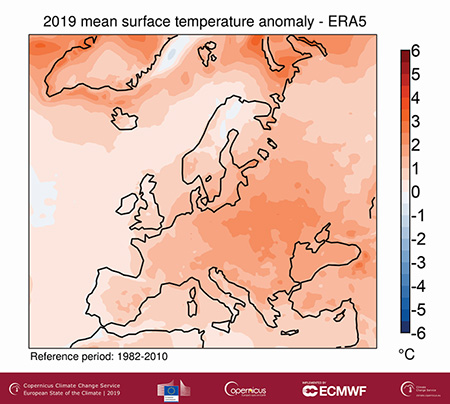
Mean surface air temperature anomalies for 2019 according to ECMWF’s ERA5 reanalysis. Nearly all of Europe was warmer than the long-term average.
Scientists at the EU-funded Copernicus Atmosphere Monitoring Service (CAMS) implemented by ECMWF constantly monitor atmospheric composition developments to see whether there are any that might be of interest to the media and the wider public. In June, we profiled ECMWF scientist Mark Parrington, who coordinates this work for CAMS and is one of ECMWF’s key science communicators.

Mark Parrington joined ECMWF in 2013.
In addition, both CAMS and C3S were quick to provide researchers, policymakers and citizens with quality-assured data and tools to help them understand how the COVID-19 lockdown was affecting air quality and how the climate and atmospheric composition might impact the spread of the coronavirus.
